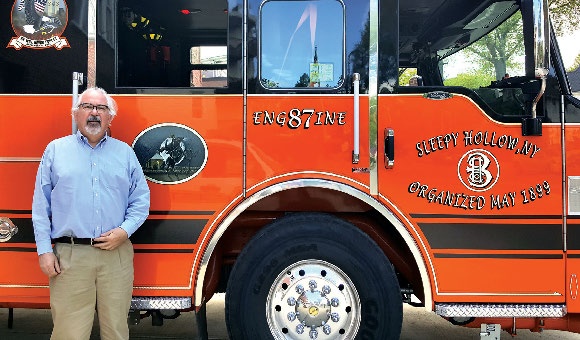Columbia College | Columbia University in the City of New York
Sleepy Hollow Mayor Takes Town Beyond the Legend
It’s tough to introduce yourself as the mayor of Sleepy Hollow without raising some eyebrows. “As in the Headless Horseman?” Indeed, and each fall Ken Wray ’77, GSAPP ’91 presides over the first of the season’s annual hayrides that trace the flight of Ichabod Crane. But the mayor of this small New York village has bigger responsibilities than nurturing an early 19th-century legend.
Top of the list: overseeing Edge-on-Hudson, an ambitious construction project on which Sleepy Hollow has pinned its hopes of economic growth. The plans call for transforming nearly 100 river-front acres — formerly a General Motors plant — into a complex with more than 1,100 housing units, commercial space, parkland and a hotel. The site had been vacant since 1996, when the plant closed, and its restoration will have a profound impact on the scenic Hudson Valley village. So in addition to typical mayoral duties like managing the budget and hiring municipal employees, Wray’s job has involved negotiating with GM and the developers.

Mayor Ken Wray ’77 with the Halloween-themed fire truck he commissioned.
Nathalie Alonso ’08
Edge-On-Hudson was conceived years before Wray was elected mayor in 2009, but legal battles, GM’s bankruptcy and other hurdles delayed construction until May 2016. Under Wray’s leadership, the village settled the pending lawsuits and successfully navigated oft- contentious negotiations with GM on the way to issuing the special permit that made development possible. Wray also negotiated a deal that allowed Sleepy Hollow to install an urgently needed water reservoir on land owned by the Rockefeller family, at no cost to the village. “Without that, we couldn’t let a single new home be built,” he says.
Edge-On-Hudson is expected to increase Sleepy Hollow’s small but diverse population — currently 10,000 residents, half of whom speak Spanish at home — by roughly a third, according to Wray, who also is executive director of The Parodneck Foundation, a non-profit that promotes affordable housing in New York City. Wray will draw from decades of experience in that field as he attempts to mitigate the effects of gentrification. “We all moved here because we liked the character of the village; we liked that it’s a village, not an anonymous ’burb,” he says.
Sleepy Hollow was known as North Tarrytown when Wray and his wife, Lynn Moffat BC’78, arrived with their three children by way of Brooklyn in 1996. The GM plant had recently shuttered, taking with it a major source of tax revenue. Seeking a cleaner, safer place to live, the couple was impressed by the school system and the community’s deep roots. They arrived in time to vote in favor of the name change to reflect the village’s place in American lore as the setting of Washington Irving’s 1820 tale The Legend of Sleepy Hollow, as well as a shift to a recreation-based economy.
Now in his fifth term as mayor, Wray got involved in local government “by accident,” he says, in 2007, when he unwittingly signed papers to run for village trustee at a Democratic Party meeting — and won. He found the work compelling and, after a two-year term on the Board of Trustees, Wray decided to run for mayor. In the last two elections he ran with Unite Sleepy Hollow, a non-partisan coalition he helped establish in 2015.
As a trustee, Wray identified and helped other candidates get elected to the board, among them David Schroedel, who served two terms. A village resident since 1986, Schroedel attributes Wray’s success, at the negotiation table and at the polls, to an ability to foster cooperation among people with different perspectives. “He puts together strong teams and challenges them to build consensus on how to approach problems,” says Schroedel.
Driven by memories of visiting state and national parks with his family — including his father, Karl Wray ’35 (now deceased), and twin brother, Mark Wray ’77 — Wray is now working to ensure that for the first time, Sleepy Hollow residents can enjoy their spectacular waterfront. As part of the deal with GM, the village received a 29-acre parcel that will be used for amenities such as an amphitheater, a community center and sports facilities. Wray also envisions outdoor art reminiscent of the Storm King Art Center, one of the world’s leading sculpture parks, further north.
“Whatever we do is going to be here for 50 years and probably longer than that,” he says. “We’re looking at this as an opportunity to shape the future of the village.”
Nathalie Alonso ’08, from Queens, is a freelance journalist and an editorial producer for LasMayores.com, Major League Baseball’s official Spanish language website. She is a regular contributor to CCT.
Issue Contents
Published three times a year by Columbia College for alumni, students, faculty, parents and friends.
Columbia Alumni Center
622 W. 113th St., MC 4530, 6th Fl.
New York, NY 10025
212-851-7852
cct@columbia.edu
Columbia Alumni Center
622 W. 113th St., MC 4530, 4th Fl.
New York, NY 10025
212-851-7488
ccalumni@columbia.edu

